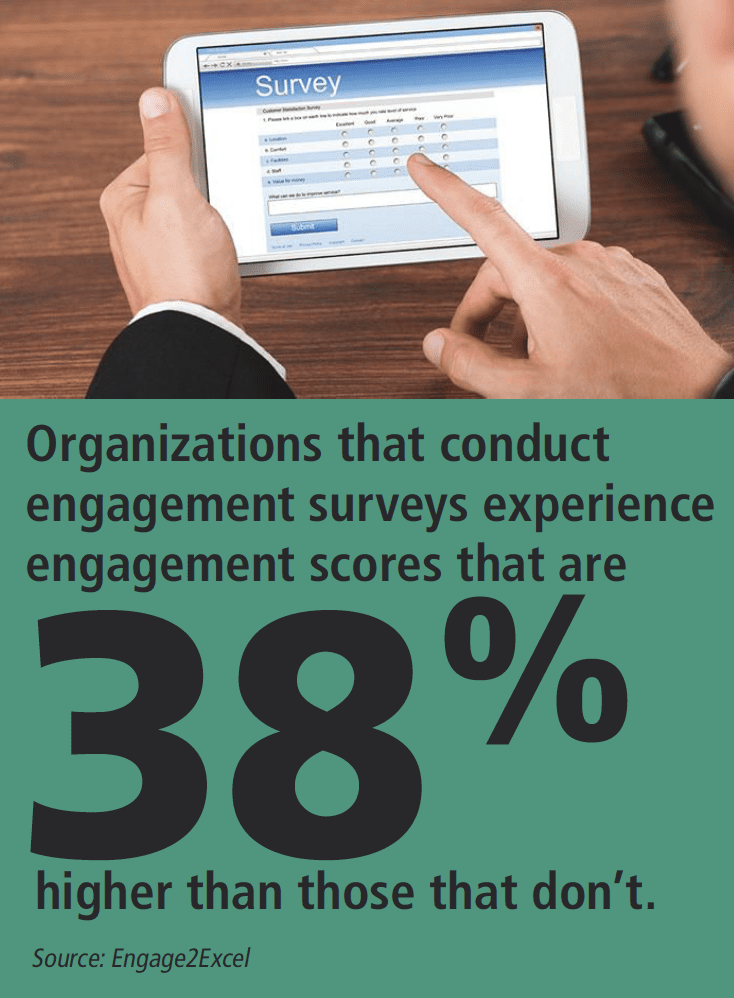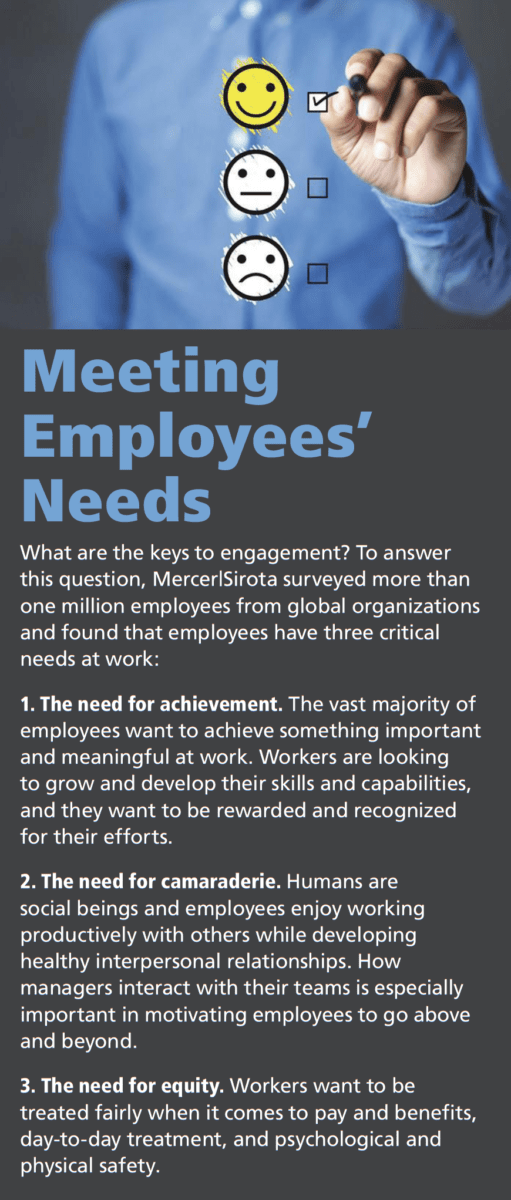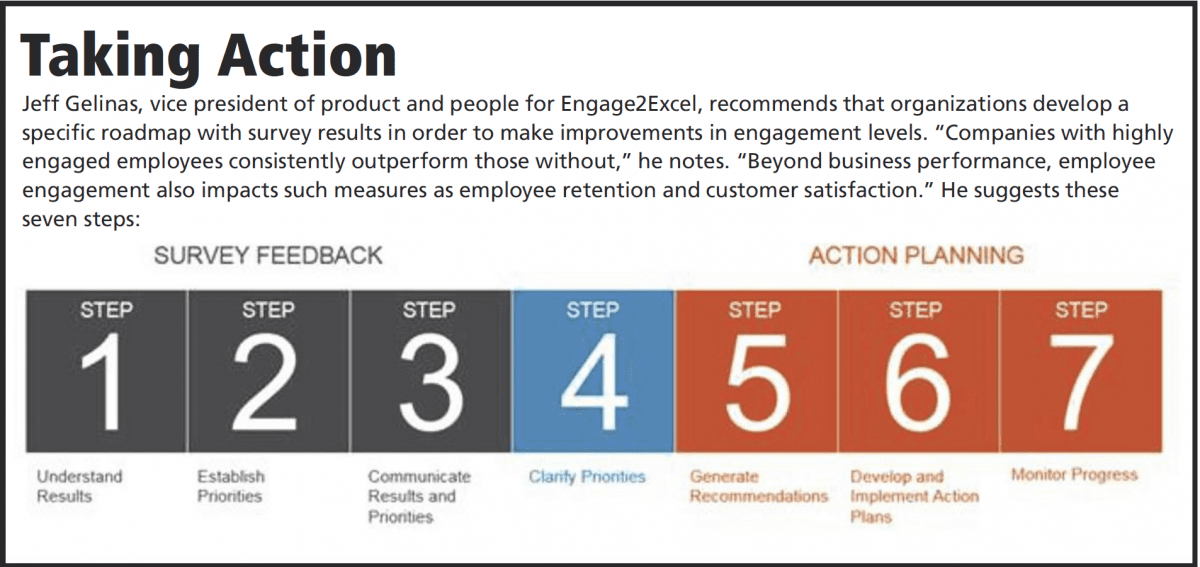Learn how employee engagement strategies and surveys can be used to drive meaningful change.
By Debbie Bolla
Employee engagement has been one of the most talked about topics in HR in recent years. It’s certainly not a new idea, but shocking statistics -both good and bad -of its impact on business have put employee engagement back on the map in a big way.
• According to Gallup, U.S. employee engagement has been holding steady around 32 percent in the last few years.
• Disengaged employees cost organizations between $450 and $550 billion annually, finds The Engagement Institute.
• Gallup finds that highly engaged business units result in:
- Twenty-one percent greater profitability;
- Forty-one percent less absenteeism; and
- Seventeen percent greater productivity.
“Engaged employees are motivated to contribute the full extent of their knowledge, skills, and abilities to help their organization succeed,” says John Mallozzi, global segment leader at Mercer|Sirota. “They care deeply about their company, want to contribute to its success, and regularly have peak experiences at work.”
So it’s no wonder that HR is searching for the right formula to drive engagement among the workforce. A good place to start is by taking a look at organizational culture.
“An organization’s culture can greatly impact how employees work with each other and how they perform their job, and affect their overall well-being,” says Mia Mends, CEO of Inspirus and Sodexo Benefits and Rewards Services. “When employees feel valued and there is authenticity in the idea that they are the foundation of culture, they enjoy coming to work, they invest in building meaningful workplace relationships, and they connect to the company’s mission and internalize the company’s objectives.”
Being connected to an organization’s work and outcomes helps employees align with its overall culture and mission, which encourages productivity and pride.
“Strong engagement occurs when employees are in a position where they understand how their role fits to the overall strategy of the organization, have a strong relationship with their manager or direct supervisor, and are engaged in meaningful work,” says Jennie Hollmann, PhD, director of organizational research for Caliper.
“When our work is more meaningful to us, we are more productive.”
Engagement Drivers
In addition to company culture, an organization can look at other factors that are linked to building an engaged workforce. These include:
- Work environment;
- Personal growth;
- Collaboration;
- Health and well-being;
- Innovation;
- Support;
- Autonomy;
- Security; and
- Recognition.
Once an organization identifies the factors that link to employee engagement as well as align with their culture and mission, they can implement certain strategies to get the most from employees:
-
- Ask employees for feedback. Greg Besner, founder and CEO of CultureIQ, says it is critical for organizations to collect regular feedback from employees -and act on it. This will “demonstrate you value the employee voice,” he says. It’s also an easy way to source and implement new ideas.
-
- Recognize employees for their contributions. More and more research is showing the link between recognition and employee engagement. According to Engage2Excel’s 2016 Trendicators report, organizations with formal length of service recognition programs see engagement scores that are 25 points higher than those that do not. Jeff Gelinas, vice president of product and people for Engage2Excel, recommends recognizing employees as early as possible -even during pre-boarding and onboarding -to encourage engagement from the onset. Be sure to consider the entire workforce and their needs and preferences, says Theresa Harkins, vice president of client success and engagement solutions at Inspirus. “Embrace the diversity of your employees by offering solutions as diverse as they are. A multigenerational workforce is attracted to employers that offer an array of rewards and benefits that aren’t one-size-fits-all,” she says.
-
- Invest in the workforce. Research shows that today’s employees are looking for professional growth. In fact, 57 percent of workers ranked opportunities to learn as one of the most important aspects of workplace culture, according to Udemy. Plus, skills development can encourage both engagement and retention. Gelinas recommends that organizations cross-train employees in order to build their skills and their ability to work across departments.
-
- Enlist an engagement champion. Besner recommends that organizations appoint a leader that is ultimately responsible for company culture and engagement. “While all leaders should champion your culture, having a designated leader in this position will increase accountability,” he explains.
Survey Says

“Annual surveys provide extensive data that can be analyzed statistically, and the findings can help understand the drivers of engagement within a particular organization, function, department, or team,” says Dr. Tracy Maylett, CEO of DecisionWise. “When these annual surveys are followed up by pulse surveys that get at some of the hotspots found in the annual survey, a complete engagement picture begins to emerge.”
Organizations can use the results from these surveys to gain a deeper understanding of the areas in which they excel as well as places for improvement. Focus groups can then be leveraged to zero in on key findings of the survey and derive more value.
“This will allow for more depth and richness to understand and explain the data,” says Caliper’s Hollmann. “Once there is a clear understanding of these data, it is important to set action plans that are directly tied to the survey results. An organization cannot tackle everything at once and should prioritize based on the overall objectives of the organization. By applying the objectives, an organization can develop a roadmap for success.”
Besner agrees that it’s important to make a list of opportunities for improvement that are aligned with overall company goals and strategy -and take it from there. “Use survey results to identify and prioritize a few key themes that leaders can use to inform action planning going forward,” he says.

The worst thing that HR can do is nothing. “The value of the survey lies in the action that takes place,” says Maylett. “Asking employees about their engagement, then doing nothing to address it, sends a clear message that ‘we don’t really care.'”
What are some actions that HR can take? A good place to start is with managers. “Managers and supervisors have a significant influence over employee engagement levels,” says Gelinas. “However, many managers fail to grasp the extent to which engagement impacts their success. Educating managers and supervisors about how engagement impacts their success and what they can do to more effectively engage employees is essential to the success of their organizations’ strategies.”
It is essential that employers provide managers with the tools needed to bring out the best in their team members. Patrick Hyland, PhD, consulting services lead at Mercer|Sirota suggests that HR professionals coach leaders and use motivational interviewing techniques to help them create personalized solutions for areas of improvement. Mentoring can also be beneficial, especially when building confidence in new managers.
“Using survey results, highly effective leaders can be paired up with those in need of help,” says Hyland. “For example, a manager who knows how to create a climate for creativity can serve as a mentor for another manager who is trying to create this same environment. Through this process, best practices can be shared and leadership networks can be built within organizations.”
Taking Data One Step Further
Engagement surveys -when done right -also have the ability to offer insight into other key metrics that are linked to productivity and profitability.
“Data from employee surveys can be used to determine what drives not only performance in an organization but also other bottom line measures such as turnover, customer satisfaction, and overall engagement,” says Hollmann.
Harkins of Inspirus recommends developing a measurement scorecard to track these metrics as well as retention and use of programs. “Track metrics with a baseline, measure over time, and ultimately tie them to organization performance data to determine the best results,” she suggests.
LEARN MORE
[metaslider id=10601]Editor’s note: According to our 2017 Reader’s Survey, our readers are most interested in a new Baker’s Dozen Customer Satisfaction Rating on employee engagement. And we are giving it to you! Look for it in our June issue.















